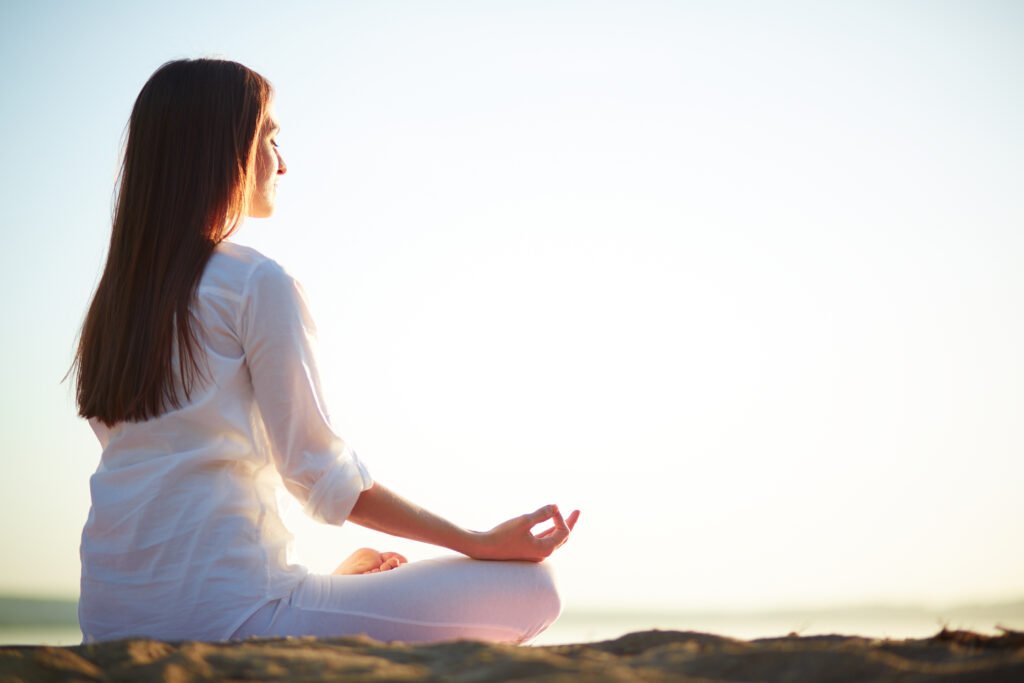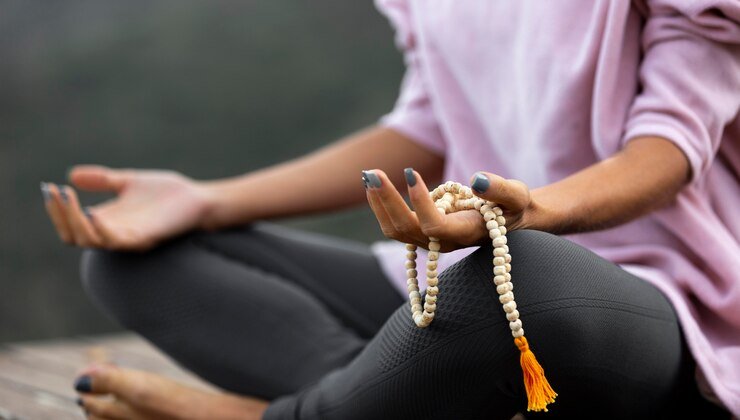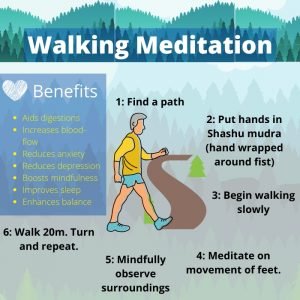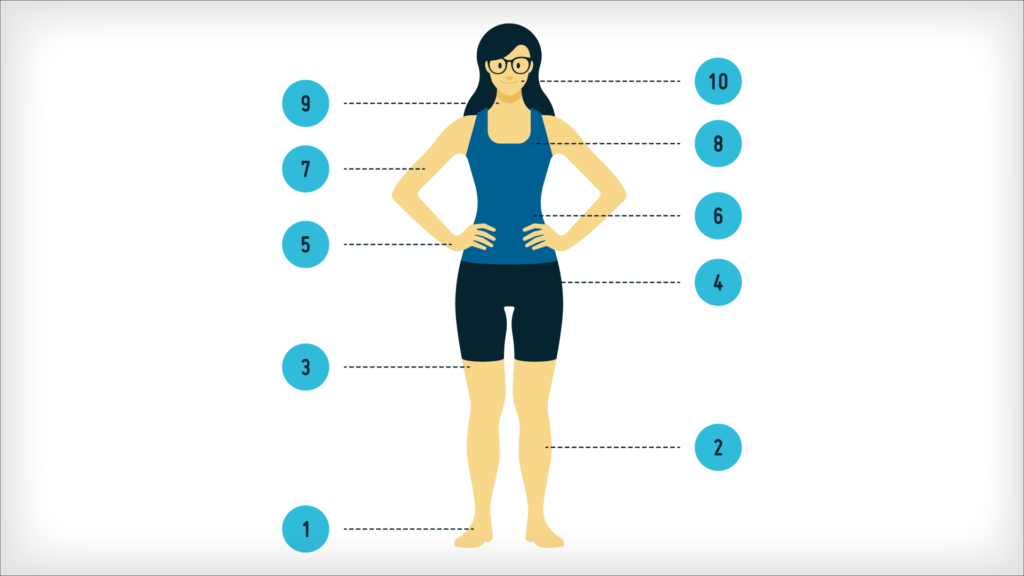Meditation has gained widespread recognition as a powerful tool for enhancing mental well-being, and its importance is rooted in various physical, psychological, and emotional benefits. To experience the magic of this meditation, we compelled a guide on free meditation techniques for beginners, aimed at effectively managing and alleviating stress, leading to improved mental health.
Meditation is a practice that involves training the mind to achieve a heightened state of awareness, focus, and inner calm.
Meditation aims to promote mental clarity, emotional well-being, and a sense of inner peace.
While there are numerous meditation techniques for mental health and wellness, they all share the common thread of encouraging a state of relaxed attention and heightened awareness.
Studies have shown that meditation can be an effective complementary approach to managing anxiety and depression. It provides individuals with coping mechanisms and tools to navigate challenging mental states.
Meditation has been associated with positive changes in brain structure and function. It can enhance cognitive abilities such as memory, decision-making, and problem-solving, contributing to overall mental sharpness.
Ideal meditation techniques for beginners
Embarking on a journey of meditation as a beginner can be rewarding. Experiment with different techniques, and remember that the essence of meditation lies in the practice itself.
Through consistent effort and an open mind, you’ll discover the transformative power of these meditation techniques on your journey to inner peace and mindfulness.
1. Breathing meditation
Breathing meditation is a contemplative practice that revolves around the awareness and regulation of one’s breath.
Practicing this simple breathing technique can completely shift your focus and state of mind.
Breathing meditation has several cognitive benefits such as increased focus, less of a wandering mind, improved arousal levels, more positive emotions, less emotional reactivity, and many more
Many people breathe shallower during times of stress, so learning how to breathe deeply can help you feel more peaceful and calm throughout the day.
How to practice:

Find a Comfortable Position
Sit or lie down with a straight spine
Relax your shoulders and hands.
- Breathe in through your nose for 4 seconds.
- Hold your breath for 7 seconds.
- Exhale firmly through your mouth, pursing the lips, for 8 seconds
- You may repeat this breathing cycle up to 4 times.
This simple technique rejuvenates the nervous system. If it makes you feel a little dizzy, don’t do any more than 3-4 breaths at first. This kind of breathing acts as a natural tranquilizer.
2. Mindful meditation
Mindful meditation encourages individuals to focus on the current moment, bringing attention to the sensations, thoughts, and feelings as they arise.
Mindful meditation activates the relaxation response, helping to regulate cortisol levels and mitigate the impact of stress on the body and mind.
It is all about being present in the here and now and not getting distracted by thoughts about the past or stressing about the future.
In typical mindfulness meditation, you might take the time to breathe deeply or even scan your body, working your way up from your toes to the top of your head
Mayo Clinic described fulness as a type of meditation where you focus on being intensely aware of what you are sensing or feeling moment by moment without judging or interpreting.
Mindfulness means doing something with 100% of your attention and focus, so you could also practice mindfulness while washing the dishes or taking a shower.
How to practice:

- Choose a quiet place where you won’t be disturbed. Sit comfortably on a chair or cushion, with your back straight and hands resting on your lap.
- Begin with a manageable duration (5-10 minutes). As you become more comfortable, gradually extend the time.
- Close your eyes or keep them open with a soft gaze. Relax your body, starting from your toes to the top of your head.
- Bring attention to your breath. Notice the sensation of each inhale and exhale.
- Thoughts will arise. Acknowledge them without judgment. Imagine each thought as a passing cloud, allowing it to drift away.
- When the mind wanders, gently bring it back to the breath. Use the breath as an anchor to the present moment.
- Pay attention to different parts of your body. Start from the toes, gradually moving up.
- Be an impartial observer of your thoughts and feelings. Let go of judgments, allowing experiences to come and go.
- When concluding, open your eyes.
3. Mantra meditation
Mantra meditation is a contemplative practice that involves the repetitive chanting or silent repetition of a sacred word, phrase, or sound, known as a mantra.
mantra is a sacred sound that is used to override linguistic thought.
In Sanskrit, the word mantra is a combination of two words- manas meaning mind and tra meaning tool– a mind tool, or rather a tool for training the mind.
Mantra meditation involves the repetition of a sacred sound, known as a mantra, to gain focus or clarity.
The mantra can be chanted aloud or repeated silently. Chanting is an age-old practice that has been used for millennia.
A few commonly known mantras are Ohm and Aham Prema, which means divine love.
Typically a mantra is repeated for a cycle of 40 days but it’s certainly not necessary for a beginning practitioner.
If you want to practice mantra meditation, simply sit quietly and ground and center yourself as you repeat your mantra 108 times. You can also count on a prayer bead or a mala.
How to practice:

- Choose your mantra- you can select a traditional mantra, often associated with spiritual traditions, or create a personal mantra that holds significance for you, such as “Om,” “Om Namah Shivaya,” “Aum Mani Padme Hum,” or any word or phrase with personal meaning.
- Choose a quiet space where you won’t be easily disturbed.
Consider lighting a candle or incense to create a peaceful ambiance.
Sit with a straight spine and relaxed shoulders. You can sit cross-legged on the floor or in a chair with your feet flat on the ground.
Rest your hands on your knees or join them together in your lap.
Begin chanting your mantra either audibly or silently. If using a traditional mantra, pronounce it clearly and with intention.
Pay attention to the sound and vibration of the mantra. Let it resonate within you.
Keep your attention on the repetition of the mantra. If your mind starts to wander, gently bring it back to the mantra.
You can synchronize the mantra repetition with your breath. For example, repeat the mantra on the inhale and exhale.
After a period of repetition (usually 10 to 15 minutes), let go of the mantra and sit in silence. Allow the effects of the practice to settle.
If your eyes are closed, open them slowly.
Stretch your body gently, and take a moment to reflect on your meditation experience.
4. Walking meditation
Walking meditation is a contemplative practice that blends the physical activity of walking with mindfulness, creating a harmonious union of movement and present-moment awareness.
During the walking meditation, steps are taken after each full breath.
Focusing on the act of walking and coordinating it with the breath enhances concentration and helps quiet the mind, fostering mental clarity.
For people who have trouble sitting still for a regular meditation practice, walking meditation can be very healing.
How to Practice :

- Select a path that is relatively free from distractions and obstacles. It could be indoors or outdoors.
- Begin by standing still, grounding yourself, and bringing attention to your breath.
- Start walking at a slower pace than usual. Pay attention to the lifting, moving, and placing of each foot. Notice the sensations in your feet and legs.
- Coordinate your steps with your breath. For example, take one step with each inhalation and another with each exhalation. Find a rhythm that feels natural.
- Keep your gaze directed downward, a few feet in front of you. Maintain a soft and gentle focus, allowing peripheral awareness of your surroundings.
- If you reach the end of your path, pause mindfully, turn around with intention, and continue walking.
- When you decide to end your walking meditation, stand still again for a moment, bring awareness to your breath, and acknowledge the completion of the practice.
5. Focus Meditation
Focus meditation, also known as concentration meditation, is a practice that involves directing and sustaining attention on a single point of focus.
Focus meditation involves focusing on an object like a flower, a candle, or a dot in the center of the circle, and taking the time to examine it to the fullest extent.
You can select anything that stimulates your senses. For example, if you chose a yellow rose, you could sit and stare at the rose and imagine yourself touching it and feeling its velvety texture. You could also pay attention to any lines or creases in the rose or immerse yourself in the color yellow.
A focus meditation is all about zeroing in on the details of something so much so that you don’t see anything else.
You can start by choosing an item of focus like a candle and sit comfortably in front of it. As you breathe in and out, notice how the flame flickers or how the flame is made of several different colors. Focus on the smells, and the sounds, and experience what it’s like to immerse yourself in the candle.
How to Practice:

- Choose a specific point of focus. Common options include the breath, a mantra, a visual object, or a specific thought.
- Sit in a comfortable position with your back straight and your hands resting comfortably. You can sit on a cushion, chair, or floor.
- Decide on a duration for your meditation session. If you’re a beginner, start with a shorter duration (e.g., 5-10 minutes) and gradually extend it as you become more comfortable.
- Close your eyes or soften your gaze, depending on your chosen point of focus. Closing your eyes can help eliminate visual distractions.
- Direct your attention fully to your chosen point of focus. If it’s the breath, observe the sensations of each inhalation and exhalation.
- Keep your attention anchored to your chosen focus. When your mind starts to wander, gently bring it back without judgment.
- Observe your thoughts and sensations as they arise. Acknowledge them, and then redirect your focus to the chosen point.
- When you’re ready to end your meditation, slowly transition out of the practice. Take a moment to observe any changes in your mental state.
6. progressive Muscle Relaxation Meditation
Progressive Muscle Relaxation (PMR) is a methodical relaxation technique that involves systematically tensing and then releasing different muscle groups to induce a deep state of relaxation.
Progressive Muscle Relaxation is based on the principle that physical relaxation can lead to mental relaxation.
The method involves tensing specific muscle groups, holding the tension briefly, and then consciously releasing the tension. This process helps individuals become more aware of the difference between tension and relaxation in various parts of the body.
How to Practice:

- Choose a quiet and comfortable space where you won’t be disturbed. Sit, stand, or lie down in a relaxed position
- Take a few deep breaths to center yourself. Inhale slowly through your nose, hold for a moment, and exhale slowly through your mouth.
- Focus on your feet. Tense the muscles in your toes and feet for about 5-10 seconds. Feel the tension, then release it completely. Notice the difference between tension and relaxation.
- Progressively move upward, tensing and then relaxing the muscles in your calves and thighs. Again, hold the tension briefly before releasing.
- Tense the muscles in your abdomen. Feel the contraction, hold briefly, and then release. Allow your abdomen to relax completely.
- Move to your upper body. Tense the muscles in your chest, back, and shoulders. Hold the tension and then release it, allowing your upper body to become loose and relaxed.
- Tense the muscles in your arms, including your hands and fingers. Hold, then release. Feel the warmth and relaxation in your arms.
- Move to your neck and face. Tense the muscles in your neck, jaw, and face. Release the tension, allowing your facial muscles to soften.
- Take a moment to scan your entire body. If you notice any residual tension, consciously release it. Allow your entire body to enter a state of deep relaxation.
- Take a few moments to breathe deeply and enjoy the sensations of relaxation. Focus on your breath and the calmness throughout your body.
- When you’re ready to end the session, gradually become aware of your surroundings. Gently move your fingers and toes, and slowly open your eyes.
You could do progressive muscle relaxation by squeezing and releasing the large muscles of the body, either starting at the top of the head or the bottom of the feet.
Takeaway
Meditation for beginners is a voyage of self-discovery—an odyssey into the realms of stillness, breath, and consciousness. The techniques presented here are gateways, each beckoning to unveil the layers of the self and invite the practitioner into the embrace of the present moment.
The art of meditation awaits, inviting all to discover the profound simplicity of being. There are many free online meditation techniques for beginners to learn at home or you can practice them by reading meditation books or journals available.




